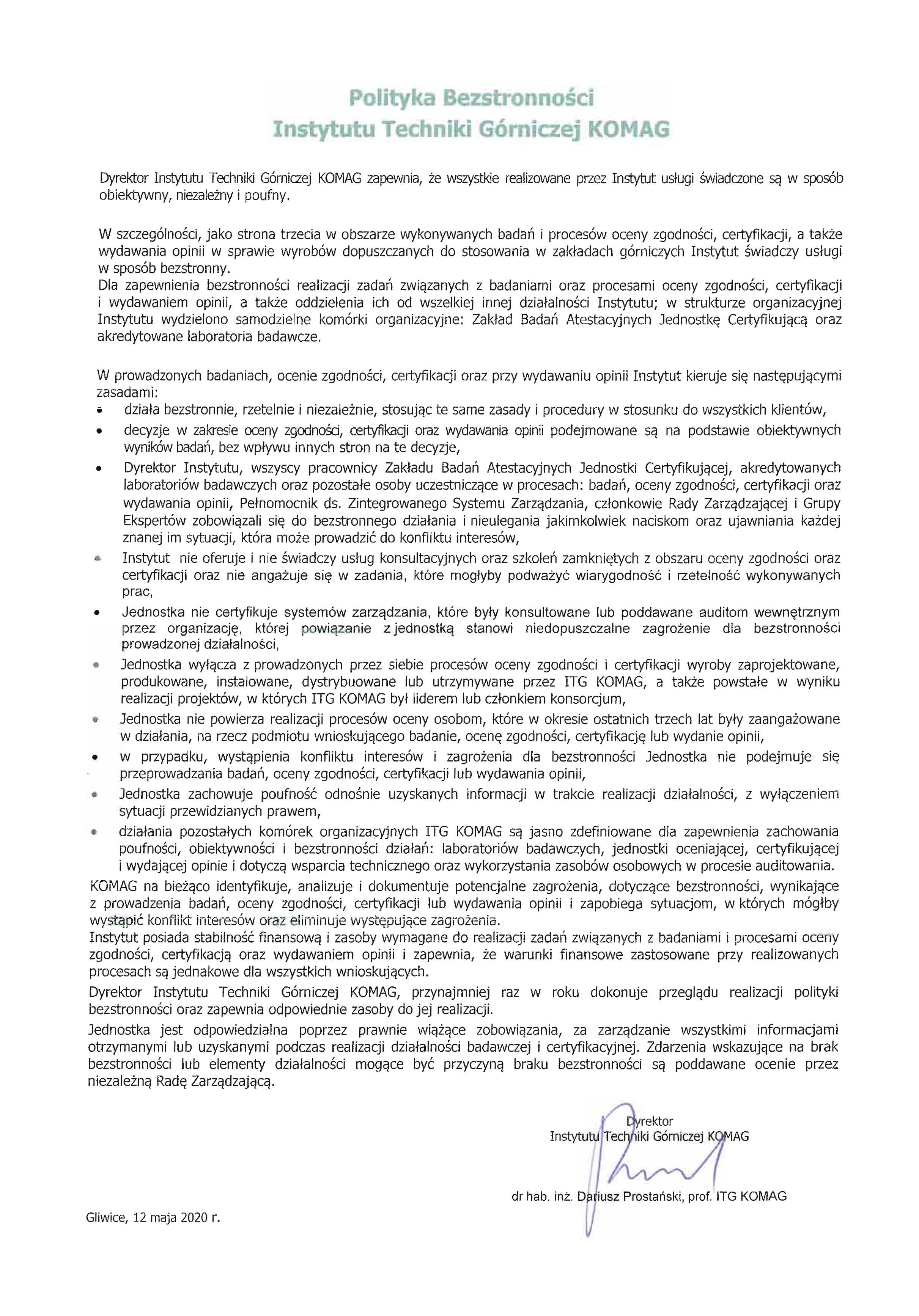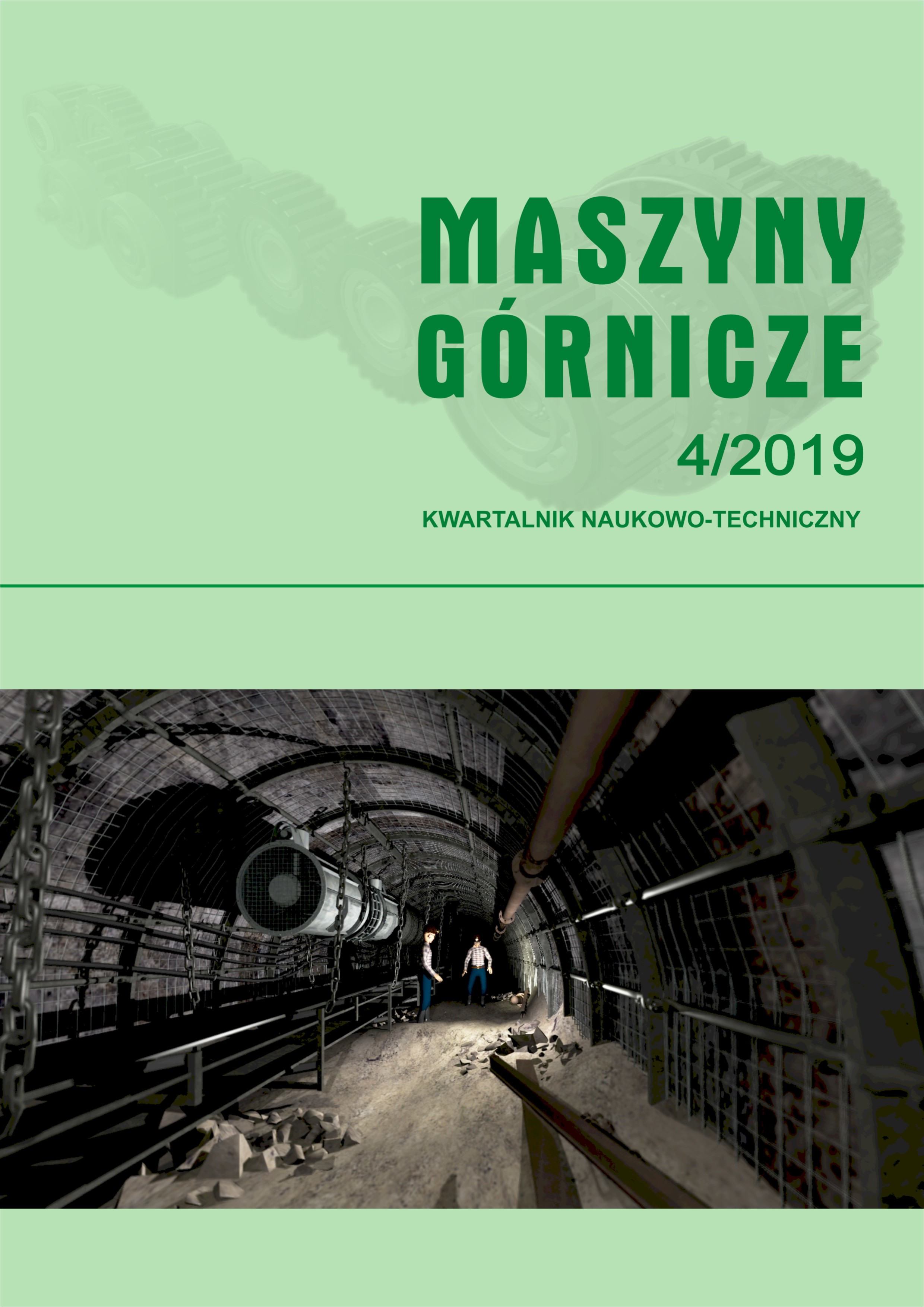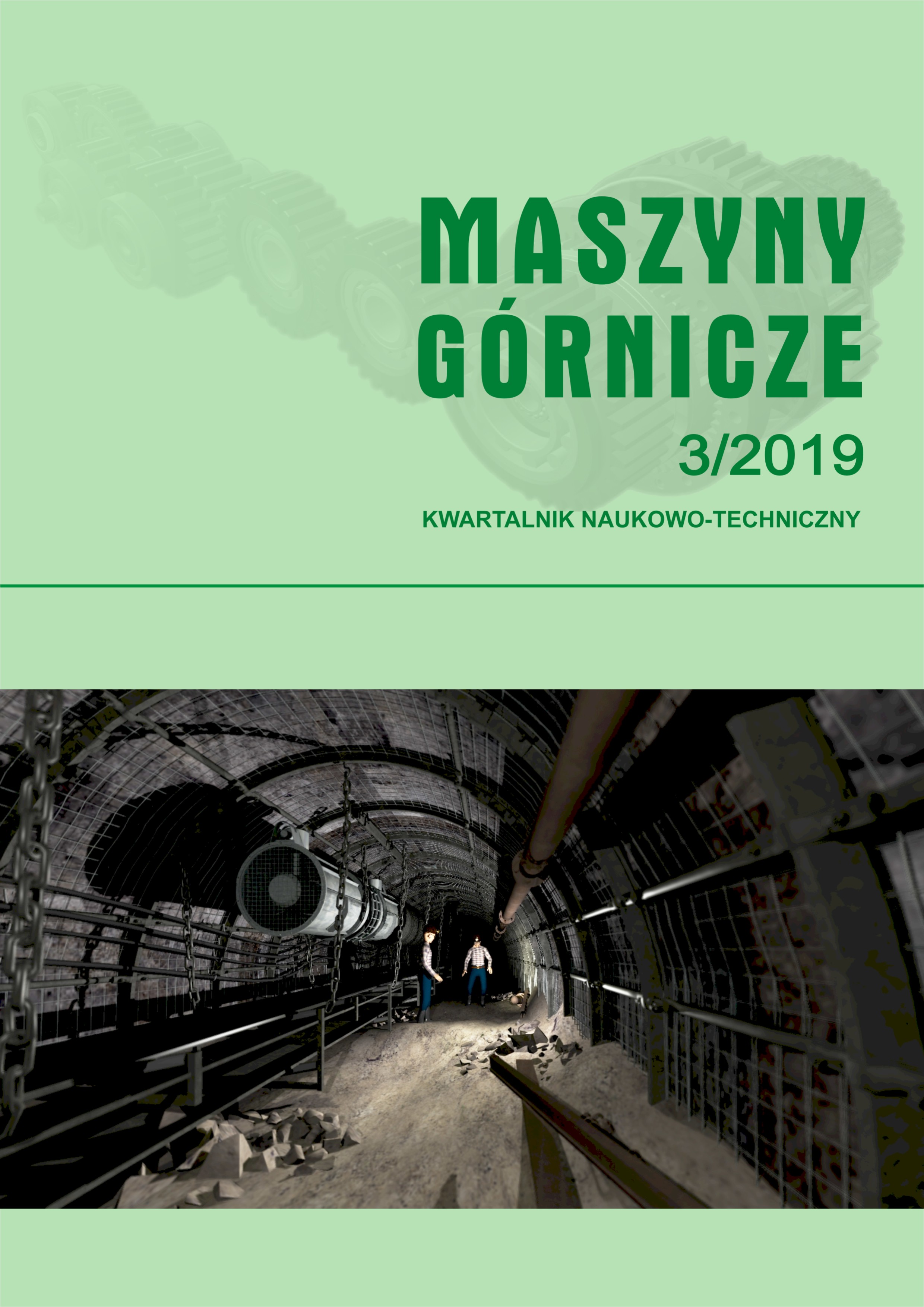KOMAG Institute of Mining Technology
MISSION
Innovative solutions for economy.
VISION
Design
Designing of machines and equipment
Tests
Laboratory of Applied Tests
Certification
Assessment of products' conformity
Projects
Projects realized by the KOMAG Institute from European Funds
Grzegorz Wiśniewski, Marcin Habrych, Bogdan Miedziński
Politechnika Wrocławska
Dariusz Macierzyński
Elgór + Hansen S.A.
Problemy pomiarów odkształconych przebiegów prądowych przy zastosowaniu dostępnych na rynku przekładników i przetworników prądowo-napięciowych
Problems of measuring distorted currents using commercially available current transformers and current-voltage transducers
str. 3-14
| W artykule przedst. porównawcze wyniki badań właściwości metrologicznych wybranych, dostępnych na rynku przekładników i przetworników prądowych. Sformułowano odpowiednie wnioski odnośnie do ich przydatności w układach pomiarowych prądów o stosunkowo małych wartościach (od 1 A do 30 A) ale o częstotliwości zmieniającej się w zakresie od 10 Hz do 550 Hz. |
The article presents comparative results of metrological properties of selected current transformers and current -voltage transducers available on the market. Appropriate conclusions were formulated regarding their usefulness in current measuring systems with relatively small values (from 1 A to 30 A) but with a frequency varying from 10 Hz to 550 Hz. |
|
| Słowa kluczowe: górnicze sieci elektroenergetyczne, przetworniki prądowo-napięciowe, przekładniki prądowe, błędy prądowe, błędy kątowe
|
Keywords: mining power networks, current-voltage converters, current transformers, current errors, angle errors |
Piotr Dobrzaniecki
Instytut Techniki Górniczej KOMAG
Urządzenia małej mechanizacji - przewijarka do kabli i lin KUP-01
Devices of small mechanization - KUP-01 cable and rope rewinder
str. 15-23
| W artykule przedstawiono opis kompaktowego urządzenia do wspomagania procesu przewijania kabli i lin. Urządzenia tego typu wykorzystywane są podczas przewijania kabli i lin z bębnów, na których dostarcza je producent, na wozy górnicze z przeznaczeniem do dalszego ich transportu. Opisana przewijarka do kabli i lin KUP-01, opracowana przez KOMAG, jest alternatywą dla obecnie stosowanych rozwiązań technicznych. |
The compact device aiding the of cables and ropes rewinding is described. Such devices are used during rewinding the ropes and cables from the drums, delivered by the manufacturer, to mine cars for their further transportation. The described cable and rope rewinder of KUP-01 type, developed by KOMAG, is an option for the currently used technical solutions. |
|
| Słowa kluczowe: górnictwo, mechanizacja prac, transport kabli i lin, przewijanie kabli i lin
|
Keywords: mining industry, work mechanization, transport of ropes and cable, cables and ropes rewinding |
Sylwester Rajwa, Zbigniew Lubosik. Marek Płonka
Główny Instytut Górnictwa
Bezpieczeństwo eksploatacji ścian zawałowych w świetle danych z systemów monitoringu
Safety of longwall mining with caving in the light of data from monitoring system
str. 24-34
| Obudowy zmechanizowane zwykle postrzega się jako urządzenia składające się głównie z części mechanicznej i hydraulicznej, natomiast pozostałe wyposażenie, głównie związane z elektroniką, traktowana jest często jako konieczne uzupełnienie systemu, zapewniające możliwość jego sterowania. Jednak rozwinięcie funkcjonalności związanych ściśle z najnowszą elektroniczną częścią wyposażenia kompleksów wydobywczych, głównie o możliwości pomiarowe i rejestracyjne, pozwala również na coraz częstsze stosowanie różnego rodzaju monitoringu, umożliwiającego obserwację pracy kompleksu wydobywczego w czasie rzeczywistym lub z niewielkim opóźnieniem czasowym, także sygnalizację stanów zagrożeń lub nieprawidłowości. Najbardziej zaawansowane systemy wyposażane są w funkcje analizujące zmiany monitorowanych parametrów, dla wypracowania ostrzeżeń o możliwych przyszłych zagrożeniach, by z wystarczającym wyprzedzeniem czasowym umożliwić reakcję operatora. Stworzenie takiego systemu predykcji wymaga zgromadzenia, a następnie przeanalizowania odpowiednio dużej i kompletnej bazy pomiarów i obserwacji, związanych przede wszystkim z różnymi utrudnieniami w prowadzeniu obudowy zmechanizowanej, a szczególnie z wydarzeniami stricte awaryjnymi, takimi jak np. obwały, stany zaciśnięcia sekcji itp. Odpowiednio opracowane zależności i wyniki analiz mogą optymalizować bezpieczeństwo pracy załogi, ograniczać trudności w utrzymania stropu wyrobisk ścianowych i co za tym następuje pozytywnie wpłynąć na uzyskiwane wyniki ekonomiczne. |
Shield supports are usually perceived as devices consisting mainly of mechanical and hydraulic parts, while other apparatus, mainly related to electronics, is often treated as a necessary supplement to the system which ensures its control. However, the development of features closely related to the latest electronic equipment in the mining complexes, mainly connected with measuring and registration possibilities, also allows for more and more frequent use of various types of monitoring. It enables observation of the operation of the mining complex in real time or with a slight time delay. What is more, it also enables signalling the operating states of the shield constituting specific threats or irregularities. The most advanced systems found abroad are equipped with functions analysing changes in specific monitored parameters to develop warnings about possible future threats to allow the operator to react with sufficient time in advance. Developing such a forecast system requires gathering and then analysing a sufficiently large and complete database of measurements and observations. These are primarily associated with various difficulties in operating a shield support, and especially with strictly emergency states, such as rock slides, shield clamping conditions, etc. The data from monitoring of shield support operation, through proper development of dependencies and analysis results, can optimize the safety of crew, reduce difficulties in maintaining the roof of longwall excavations and thus have a positive impact on the obtained economic results. |
|
| Słowa kluczowe: górnictwo, obudowa zmechanizowana, monitoring, podporność
|
Keywords: mining, shield support, monitoring, load bearing capacity |
Tomasz Trawiński, Marcin Szczygieł
Politechnika Śląska
Przemysław Deja, Bartosz Polnik
Instytut Techniki Górniczej KOMAG
Akumulatorowy układ zasilania urządzenia wiercącego realizowanego w ramach projektu INDIRES
„Praca naukowa finansowana ze środków finansowych na naukę w latach 2017-2020 przyznanych na
realizację projektu międzynarodowego współfinansowanego”
Battery power supply system for the drilling device developed as part of the INDIRES project
str. 35-44
| W artykule przedstawiono wyniki pracy jakie zrealizowano w ramach projektu europejskiego INDIRES. Głównym celem realizowanego projektu jest poprawa bezpieczeństwa pracy w górnictwie, poprzez opracowanie nowych technologii wspomagających pracę ratowników górniczych, powiązanych z innowacyjnymi technologiami komunikacyjnymi możliwymi do zastosowania w przestrzeniach potencjalnie zagrożonych wybuchem metanu i/lub pyłu węglowego. |
In the list of search results implemented as part of the INDIRES public project. The main goal of the implemented project is to improve work safety in mining, by developing new technologies supporting the work of mining rescuers, using innovative communication technologies that can be used in potentially explosive methane and / or coal dust. |
|
| Słowa kluczowe: górnictwo, maszyny elektryczne, zasilanie akumulatorowe, urządzenie wiercące
|
Keywords: mining, electric machines, battery supply, drilling device |
Krzysztof Nieśpiałowski, Mateusz Wójcicki
Instytut Techniki Górniczej KOMAG
Agregaty konstrukcji KOMAG przeznaczone do chłodzenia silników elektrycznych dużych mocy
Cooling devices designed by KOMAG intended for cooling the high-power electric motors
str. 45-52
| Powszechnie stosowane w krajowym górnictwie chłodzenie maszyn wyposażonych w napędy elektryczne dużych mocy wodą z magistrali ppoż. odprowadzaną po zużyciu do kanału ściekowego, generuje duże problemy technologiczne i ekonomiczne związane z jej ponownym odprowadzeniem na powierzchnię. W artykule przedstawiono koncepcję otwartego i zamkniętego układu chłodzenia górniczych maszyn dużych mocy. Stanowią one alternatywę dla metody powszechnie wykorzystywanej. Porównano wady i zalety omawianych układów w zależności od warunków zastosowania. |
Cooling of the machines used in the mining industry, equipped with high-power electric drives, by water from the mine fire system generates technological and economic problems associated with re-transportation of water to the surface. The concept of open and closed system for cooling the high-power mining machines is presented. This is an alternative to the commonly use method. Advantages and disadvantages of the discussed systems are compared. |
|
| Słowa kluczowe: górnictwo, maszyny górnicze, napędy elektryczne, układ chodzenia
|
Keywords: mining industry, mining machines, electric drives, cooling system |
Sebastian Janas, Marek Kalita, Zbigniew Szkudlarek
Instytut Techniki Górniczej KOMAG
Drążenie pomocniczych tuneli ratowniczych
„Praca naukowa finansowana ze środków finansowych na naukę w latach 2017-2020 przyznanych
na realizację projektu międzynarodowego współfinansowanego”
Driving the auxiliary rescue tunnels
str. 53-59
| W artykule przedstawiono metodę drążenia pomocniczych tuneli ratowniczych z wykorzystaniem mało średnicowej głowicy tnąco-ładującej, która wykorzystuje pulsujący moment obrotowy o częstotliwościach odpowiednio dobranych dla urabianej skały. Jest ona zabudowana na platformie wiertniczej. Zaprezentowano budowę i opisano główne elementy głowicy. |
Method of driving auxiliary rescue tunnels using the small-diameter cutting-loading head, with the pulsating torque of the frequencies selected for the type of mined rock is presented. The head is installed on a drilling platform. The design and main components of the head are presented. |
|
| Słowa kluczowe: inżynieria mechaniczna, budowa i eksploatacja maszyn, ratownictwo górnicze, tunel ratowniczy, sprzęt wiertniczy
|
Keywords: mechanical engineering, machine design and use, main rescue operations, rescue tunnel, drilling equipment |
Andrzej Figiel
Instytut Techniki Górniczej KOMAG
Badanie i ocena przewodów i kabli elektrycznych
Testing and assessment of electric cables
str. 3-9
| Przewody i kable elektryczne, optyczne i telekomunikacyjne, zanim zostaną wprowadzone do obrotu handlowego, podlegają ocenie za którą odpowiada ich producent. Użytkownik instalacji kablowych jest z kolei odpowiedzialny za prawidłowy dobór kabli i przewodów, ze względu na bezpieczeństwo osób użytkujących instalację. W artykule zaprezentowano wymagania dotyczące kabli i przewodów elektrycznych przeznaczonych do stosowania w podziemnych zakładach górniczych oraz zakres badań wymaganych podczas oceny dokonywanej przez ITG KOMAG. |
Before being placed on the market, electrical, optical and telecommunication cables shall undergo an assessment under the responsibility of their manufacturer. The user of the cable systems is responsible for the correct selection of cables for the safety of the persons using the system. The article presents the requirements for electrical cables intended for use in underground mines and the scope of tests required during the assessment carried out by ITG KOMAG. |
|
| Słowa kluczowe: kable elektryczne, instalacje kablowe, badania kabli
|
Keywords: electrical cables, cable installations, cable tests |
Amadeus Jagieła-Zając, Piotr Cheluszka
Politechnika Śląska
Pomiary ustawienia uchwytów nożowych na pobocznicy głowicy urabiającej kombajnu górniczego z wykorzystaniem widzenia stereoskopowego
Measurement of the pick holders position on the side surface of the cutting head of a mining machine with the use of stereoscopic vision
str. 10-23
| O efektywności urabiania skał kombajnami górniczymi decyduje w dużym stopniu układ noży, a więc liczba i sposób ich rozmieszczenia na organie roboczym maszyny urabiającej. Istotne znaczenie ma nie tylko prawidłowy dobór układu noży do danych warunków na etapie projektowania, lecz również zapewnienie zgodności z projektem gotowego wyrobu. Dąży się m.in. dlatego do robotyzacji procesu wytwarzania głowic/organów urabiających kombajnów górniczych. Z punktu widzenia możliwości robotyzacji procesu spawania uchwytów nożowych niezbędna jest ocena w czasie rzeczywistym ustawienia uchwytów nożowych względem powierzchni pobocznicy kadłuba głowicy urabiającej. Dogodnym sposobem jest tu wykorzystanie bezstykowych metod pomiaru, opartych na systemach wizyjnych. W artykule przedstawiono metodę wyznaczania ustawienia uchwytów nożowych względem pobocznicy kadłuba głowicy urabiającej kombajnu chodnikowego, w trakcie ich pozycjonowania, z wykorzystaniem systemu wizyjnego 3D. Przetwarzanie danych zrealizowane zostało w środowisku Matlab z wykorzystaniem bibliotek pakietu Computer Vision Toolbox. Przestawiono model matematyczny opisujący transformację obrazów zarejestrowanych przez kamery, w oparciu o którą wyznaczono rozkład odległości pomiędzy punktami podstawy uchwytu nożowego i pobocznicy kadłuba głowicy urabiającej, dla zadanego ustawienia uchwytu nożowego. Opracowaną metodę pomiaru przetestowano na stanowisku doświadczalnym zbudowanym w Laboratorium robotyki Katedry Mechanizacji i Robotyzacji Górnictwa Politechniki Śląskiej |
Before being placed on the market, electrical, optical and telecommunication cables shall undergo an assessment under the responsibility of their manufacturer. The user of the cable systems is responsible for the correct selection of cables for the safety of the persons using the system. The article presents the requirements for electrical cables intended for use in underground mines and the scope of tests required during the assessment carried oThe efficiency of rock cutting with mining machines is largely determined by the arrangement of picks, i.e. the number and their arrangement on the working unit of the mining machine. Not only the correct selection of the pick system for given conditions at the design stage is important, but also ensuring compliance with the design of the finished product. Strives, among others therefore, for robotisation of the process of manufacturing cutting heads/drums. From the point of view of the robotisation of the pick holders welding process, it is necessary to assess in real time the position of the pick holders relative to the side surface of the cutting head body. A convenient way is to use contactless measurement methods based on vision systems. The article presents a method of determining the position of pick holders relative to the side surface of the cutting head body of a roadheader, during their positioning, using a 3D vision system. Data processing was carried out in the Matlab software using the libraries of the Computer Vision Toolbox. A mathematical model describing the transformation of images recorded by cameras has been presented. On the basis of this model, the distribution of distances between the pick holder base points and the side surface of the cutting head was determined for a given pick holder setting. The developed measurement method was tested on an experimental stand built in the Laboratory of robotics of the Department of Mining Mechanization and Robotisation at the Silesian University of Technology.ut by ITG KOMAG. |
|
| Słowa kluczowe: głowica urabiająca, uchwyty nożowe, widzenie stereoskopowe, pomiary stereometrii
|
Keywords: cutter head, pick holders, stereoscopic vision, stereometry measurements |
Zbigniew Szkudlarek Sebastian Janas
Instytut Techniki Górniczej KOMAG
Wygarniacz portalowy
Portal stacker-reclaimer
str. 24-29
| W artykule przedstawiono koncepcję wygarniacza portalowego, przewidz. do zastosowania w branży energetycznej, głównie w magazynach gipsu instalacji odsiarczania spalin lub magazynach żużla piecowego. Oprócz wykorzystywania wygarniacza do dostarczania materiału sypkiego na linię produkcyjną może on pełnić rolę wstępnego mieszania materiałów sypkich. Składowany materiał może bowiem stanowić mieszaninę dużej ilości warstw o zróżnicowanym składzie chemicznym. W artykule przedstawiono budowę oraz opisano proces rozładunku materiału niehomogenizującego przez wygarniacz portalowy dwuramieniowy. Składowany materiał do dalszego wykorzystania jest pobierany z obu boków pryzmy. |
The concept of portal stacker-reclaimer to be used in the power industry, mainly in the gypsum storehouses for exhaust gases desulphurisation or in the furnace slag storehouses is presented. Apart using the portal stacker for delivery of loose materials to the production line, it can play a role of the initial mixer of loose materials. The stored material can be a mixture of many layers of different chemical composition. Design of the portal stacker is presented and the process of using two-arm portal stacker for unloading the material, which do not require homogenization, is described. The stored materials are taken from both sides of the prism. |
|
| Słowa kluczowe: inżynieria mechaniczna, budowa i eksploatacja maszyn, wygarniacz portalowy, proces rozładunku
|
Keywords: mechanical engineering, construction and operation of machines, portal reclaimer, unloading process |
Krzysztof Nieśpiałowski
Instytut Techniki Górniczej KOMAG
Elektropneumatyczne sterowanie filtra samoczyszczącego
Electropneumatic control system for self-cleaning filter
str. 30-41
| W artykule przedstawiono elektropneum. układ sterowania dedykowany do filtra samoczyszczącego FS-60 konstrukcji ITG KOMAG. Omówiono budowę i zasadę działania układu elektropneumatycznego. Rozwiązanie stanowi alternatywę dla istniejącego układu sterowania pneumatycznego. W artykule przedstawiono zalety i wady tego rozwiązania. |
The electropneumatic control system dedicated to FS-60 self-cleaning filter designed by KOMAG is presented. Design and principles of operation of the electropneumatic system is discussed. This solution is an alternative to the present pneumatic control system. Advantages and disadvantages of such |
|
| Słowa kluczowe: filtracja, filtr, filtr samoczyszczący, sterowanie, sterowanie elektropneumatyczne | Keywords: filtration, filter, self-cleaning filter, control system, electropneumatic control |
Krzysztof Okrent
KGHM ZANAM S.A.
Przemysław Deja, Bartosz Polnik
Instytut Techniki Górniczej KOMAG
Zastosowanie ogniw litowych do zasilania urządzeń technologicznych w górniczych wozach strzelniczych
The use of lithium batteries to power technological equipment in blasting utility vehicles
str. 42-49
| W samojezdnych wozach strzelniczych do napędu układu jezdnego zastosowany jest wysokoprężny silnik spalinowy. Natomiast do napędu urządzeń technologicznych, zabudowanych na tych wozach, stosowany jest silnik elektryczny, który napędza pompę hydrauliczną. Silnik elektryczny zasilany jest z kopalnianej sieci elektroenergetycznej o napięciu znamionowym 500 V za pośrednictwem rozwijanego przewodu elektrycznego. W artykule przedstawiono nowe, akumulatorowe rozwiązanie zasilania silnika elektrycznego samojezdnego wozu strzelniczego. Układ ten składa się z modułu baterii i aparatury, zabudowanych na wozie strzelniczym oraz wolnostojącego modułu ładowania. Wprowadzenie akumulatorowego zasilania układu roboczego zabudowanego na wozie, w miejsce stosowanego w dotychczasowych rozwiązaniach zasilania przewodowego, jest istotną innowacją wozu strzelniczego. Zastosowane w tym rozwiązaniu ogniwa litowe charakteryzują się wysoką gęstością energii oraz wysoką gęstością mocy, w stosunku do powszechnie stosowanych baterii ogniw kwasowo-ołowiowych i nie wydzielają gazów elektrolitycznych (np. wodoru) podczas eksploatacji. |
Self-propelled blasting utility vehicles are powered by diesel engines. However, electric motors are used to power the technological devices installed on these vehicles, and such a motor powers a hydraulic pump. The electric motors are powered from the mine's power grid with a rated voltage of 500 V via an unwound electric cable. A new battery solution for the electric motor of a self-propelled blasting utility vehicle is presented. This system consists of a battery module and fittings, installed on a blasting utility vehicle and a free-standing charging module. The introduction of battery power supply unit to the working system installed on the vehicle instead of the wired power supply used in existing solutions is an important innovation of the blasting utility vehicles. The lithium cells used in this solution are characterized by high energy density and high power density, compared to commonly used lead-acid batteries and during operation do not emit electrolytic gases (e.g. hydrogen). | |
| Słowa kluczowe: górnictwo, maszyny elektryczne, zasilanie akumulatorowe | Keywords: mining industry, electric machines, battery power supply system |
Krzysztof Nieśpiałowski
Instytut Techniki Górniczej KOMAG
Agregat hydrauliczny przeznaczony do zasilania napędu taśmowego urządzenia czyszczącego
Hydraulic power pack for supplying the drive of belt cleaning device
str. 50-55
| W niniejszym artykule zaprezentowano koncepcję agregatu hydraulicznego, przeznaczonego do zasilania układu napędowego taśmowego urządzenia czyszczącego, będącego zespołem pomocniczym głównych przenośników taśmowych. Agregat o zwartej konstrukcji wyposażono w pompę, wraz z zaworem przelewowym, zatopioną w zbiorniku oleju. Kompaktowa budowa umożliwi zabudowę agregatu wewnątrz konstrukcji nośnej przenośnika taśmowego. To z kolei pozwoli na sprzężenie wału pompy, za pomocą przekładni pasowej, z bębnem wysypowym przenośnika taśmowego. |
The concept of hydraulic power pack for supplying the drive of belt cleaning device being an auxiliary subassembly of the main belt conveyors is presented. The power pack of a compact design is equipped with a pump with an overflow valve and immersed in an oil tank. The compact design will enable installation of the power pack inside the load-bearing structure of a belt conveyor. This, in turn, will enable coupling the pump shaft, using a belt drive, with a discharge drum of the belt conveyor. | |
| Słowa kluczowe: górnictwo, transport urobku, urządzenie czyszczące, agregat hydrauliczny | Keywords: mining industry, run-of-mine transportation, cleaning device, hydraulic power pack |
| Projects realized by the KOMAG Institute from European Funds: |

KOMTRACK New generation haulage system of highly productive longwall systems
Funding
The Attestation Testing Department Certification Unit operates within the structures of the KOMAG Institute of Mining Technology as an autonomous and independent unit.
The Institute, in the field of certification activities, conformity assessment and testing of products under the approval procedure, does not benefit from public aid or any other funds.
Fees related to certification paid by clients are determined, among other things, taking into account the principles set forth in the Regulation of the Minister of Development of August 22, 2016 on the manner of determining fees for activities related to mandatory conformity assessment of products (Journal of Laws 2016, item 1373).
Fees related to the implemented processes paid by Customers, are determined taking into account the principles set forth in the Price List. The costs of product evaluation, issuance, amendment and supervision of certificates are paid in full by the Applicant.
The impartiality and independence, of the Institute's certification and conformity assessment body is supervised by the Governing Board, which, in accordance with the regulations, annually evaluates the principles of the financial policy of the body in terms of its impartiality and the potential impact of commercial factors on the objective conduct of certification activities.
Impartiality
ITG KOMAG in the field of certification and conformity assessment, bearing in mind the public confidence in the conducted processes of certification of management systems, products, services, conformity assessment, makes every effort to maintain impartiality during them and to be perceived as an impartial entity, and thus contribute to confidence for the entire system of certification and conformity assessment.
Our goal is to make certification and conformity assessment decisions on the basis of objective evidence of conformity (or non-conformity) obtained and the absence of influence of any interest groups or other parties on these decisions.
To this end, an Impartiality Policy has been established and a Governing Board has been established to periodically assess the impartiality of the Certification Body's Attestation Department's certification and conformity assessment activities.

Confidentiality
The Attestation Testing Department Certification Body ensures that at all levels of the organizational structure it declares confidentiality of all information obtained in connection with conformity assessment, certification, testing or inspection processes. The information obtained shall not be disclosed to a third party without the written consent of the applicant. If any information is required by law to be disclosed to a third party, the client is notified in advance of the need for disclosure.
Contact:
Manager: Andrzej Figiel, Ph.D. Eng.
email: This email address is being protected from spambots. You need JavaScript enabled to view it.
phone +48 32 2374604, +48 32 2374570
fax: +48 32 2374581










 Badanie bezpieczeństwa wyrobów
Badanie bezpieczeństwa wyrobów Klaster Maszyn Górniczych
Klaster Maszyn Górniczych